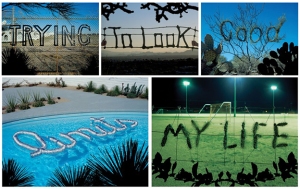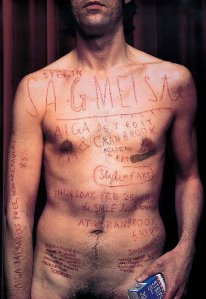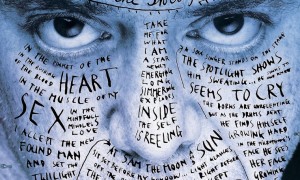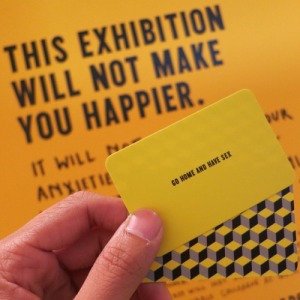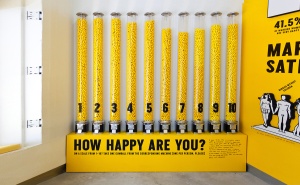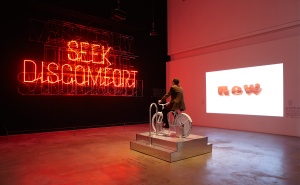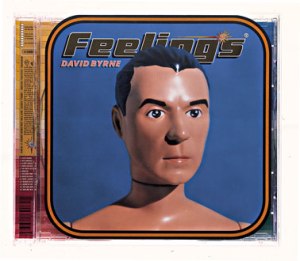Stefan Sagmeister was born in Austria in 1962 where he later studied Graphic Design at the University of Applied Arts Vienna, he then attained his masters degree at the Pratt Institute in New York where began his first design firm Sagmeister Inc working with prolific musicians such as Lou Reed and Rolling Stones.
The dry biography nonsense aside, Sagmeister is truly interesting because the sheer amount of personality and humour he can insert into his work, no matter who he is working for his work feels distinctly his own. Looking at graphic design from the perspective of an illustrator, especially one who puts such stock in illustrations humanity and idiosyncrasies as one of its greatest strengths, graphic design can often feel stark and impersonal by comparison. Sagmeister defies his titles expectations and blurs lines between practices acting as an artist, graphic designer and typographer all across one piece of work. Sagmeister however sees things a little more simplisticly:
“I see it all as graphic design, It’s made by a graphic design office in mediums normally employed by design and all has a client behind it. But from a viewer’s point of view it doesn’t matter. The whole question of art versus design has limited interest – it comes in waves, in the 20th century there were times when art and design were embedded in each other, the Bauhaus for instance, and then they separated, and then they came back together, and then they separated… from the viewer’s point of view, it’s always just a question of ‘is it good or not?’.”
Sagmeister has also gone above and beyond the role of practitioner and has taken on the form of a father figure in graphic design. His “Things I Have Learned In My Life So Far” is a series of twenty maxims on life, a series of guide lines which at face value appear as general life advice, take on whole new meaning when read from the perspective of a designer.
1. Helping other people helps me.
2. Having guts always works out for me.
3. Thinking that life will be better in the future is stupid. I have to live now.
4. Organising a charity group is surprisingly easy.
5. Being not truthful always works against me.
6. Everything I do always comes back to me.
7. Assuming is stifling.
8. Drugs feel great in the beginning and become a drag later on.
9. Over time I get used to everything and start taking for granted.
10. Money does not make me happy.
11. My dreams have no meaning.
12. Keeping a diary supports personal development.
13. Trying to look good limits my life.
14. Material luxuries are best enjoyed in small doses.
15. Worrying solves nothing.
16. Complaining is silly. Either act or forget.
17. Everybody thinks they are right.
18. If I want to explore a new direction professionally, it is helpful to try it out for myself first.
19. Low expectations are a good strategy.
20. Everybody who is honest is interesting.
Advice given in this list when looked at as a designer touches on ideas of collaboration, risk taking and personal organisation, all of which play an integral roll in furthering my own practise.
TED Talks: Stefan Sagmeister – The Power of Time Off
http://www.ted.com/talks/stefan_sagmeister_the_power_of_time_off?language=en
Sagmeisters approach the design and art has always been striking and bold with distinctly personal and emotional ties. He accredits this ability to pack a wide reaching but still intimate punch with remaining part of a small collective rather than becoming part of a large scale design firm. Being able to sit back and observe the direction contemporary design and then pick up and sail directly into the wind has always been one of his company’s greatest strengths.
“In the early nineties, when the modernism revival started and many designers opted for cold, slick design, it seemed a natural reaction for us to go the other way. My feeling was that so many viewers are left untouched by those machine-like visuals out there; that a more human approach seemed a smart alternative.”
Sagmeister’s contrarian attitude has been apparent throughout his career, perhaps most famously in his 1999 poster for a talk he was giving at AIGA in which he had an apprentice carve the details of the talk into his own chest using a craft knife:
recalling ideas of tattooing and branding which have been present for thousands of years, for spiritual, practical and decorative uses. Sagmeister utilised this form of self mutilation to startlingly communicate something that could have just as easily been printed on times new roman on an a4 sheet of paper, whether it exists as a commentary on indelibly scarring oneself in the name of art or simply as a striking advertisement for his craft is unclear. This mix of absurdist humour and sensationalist attitude help to make Sagmeister such an exciting practitioner.
Sagmeisters work seems to be a direct response to his environment, living in New York surrounded by designers working in a digital manner, he (partly due to a self confessed difficulty using computers) produced tangible hand crafted work. When the design community began to produce clinical, almost impersonal work, he threw as much of his own personality into his own as possible. He is so important because defies trend and convention as much as possible.
Sagmeister and his affiliates often create physical instillations rather than digital ones, many of Sagmeister’s later works have incorporated an element of interactivity for work particularly in his ICA show entitled “The Happy Show” a show combining typography and graphic design but frankly the demanding the viewer engage with the work, giving advice and directions of how to engage with the work and in one case prompting the audience to power a light instillation using a stationary bike.
The whole show works dynamically with the exhibition space itself annotations made to mundane fittings such as plug sockets creating a signature playful and surprising atmosphere.
TED Talks: Stefan Sagmeister – Happiness By Design
http://www.ted.com/talks/stefan_sagmeister_shares_happy_design?language=en
Sagmeister’s best known work is probably his series of album cover designs, working with artists including The Rolling Stones, Aerosmiths and David Byrne. Sagmeisters work on albums has a distinctly more illustrative feel than his other projects. Sagmeister has not branched much further into entertainment branding i.e film and television.
“People like the Star Wars poster because they like the film, but the poster itself is ultimately a piece of shit. It’s a realistic illustration with some typeface on it related to what’s happening in the film.”
“It’s a reduction of something that’s inherently visual into a single image and that process is inherently uninteresting. It’s a very straightforward graphic design thing – you might as well design a logo.”
I quite like the Star Wars poster, but Sagmeister’s desire to create something distinct and appreciated on its own merit as a piece of art, separate from the zeitgeist generated by whatever piece of music it is accompanying is commendable and another example of his boldness and personality seeping through into his own work.
His will to educate and share what he has learned during his illustrious career combined by his blatant refusal to adhere to design trends make Stefan Sagmeister one of the most important and interesting designers operating today.

